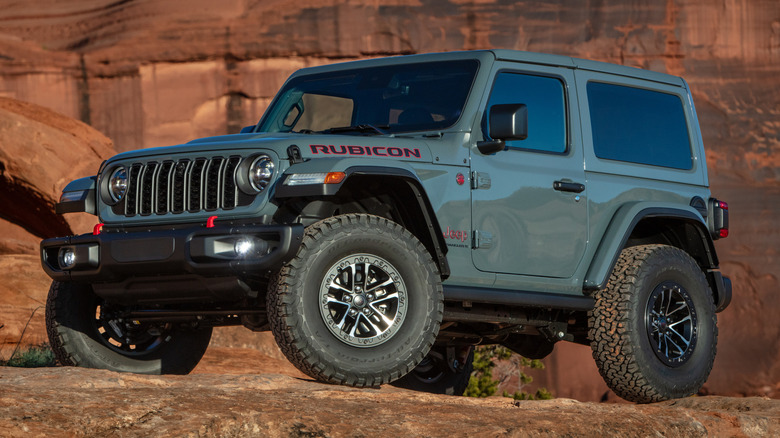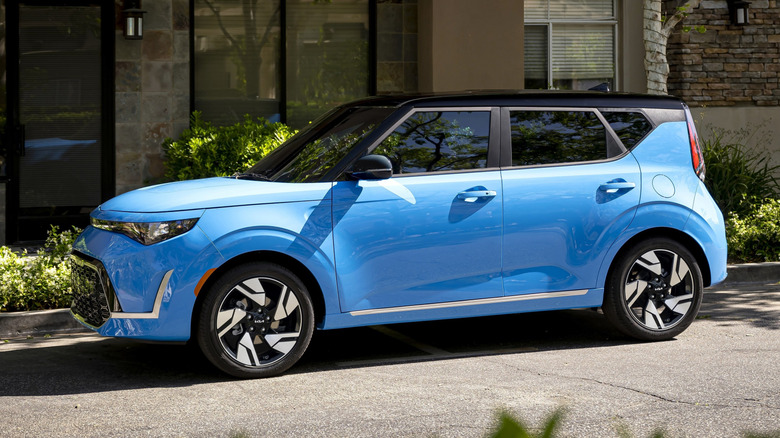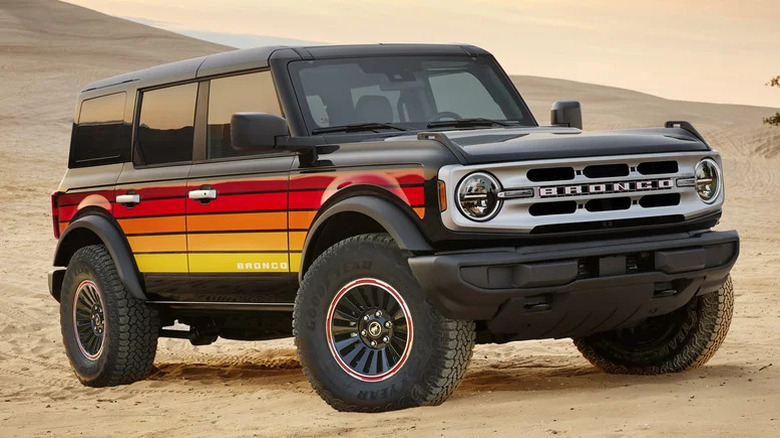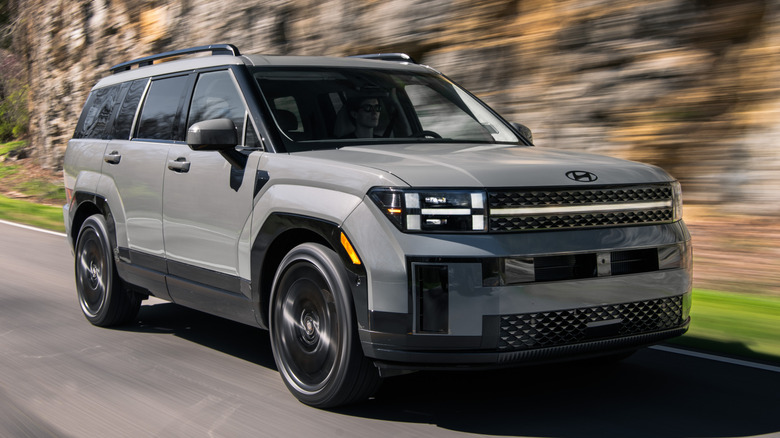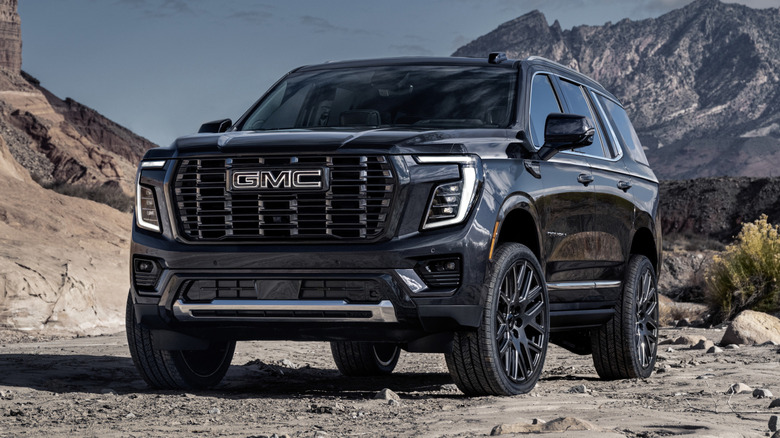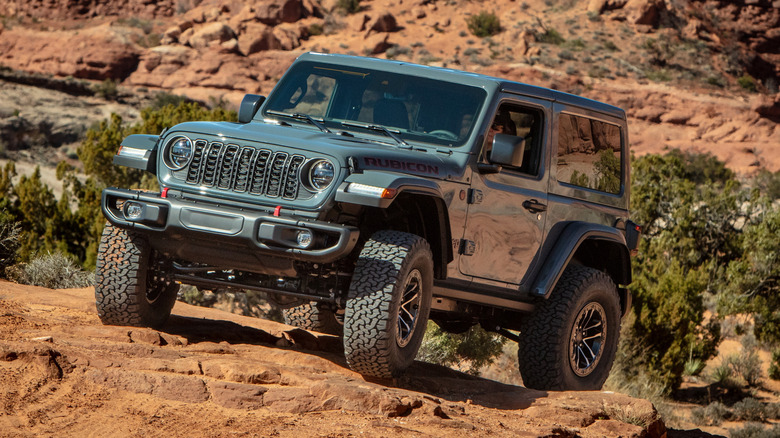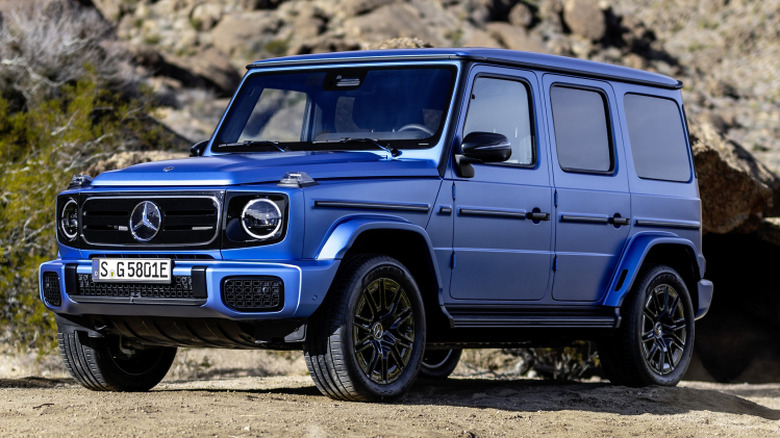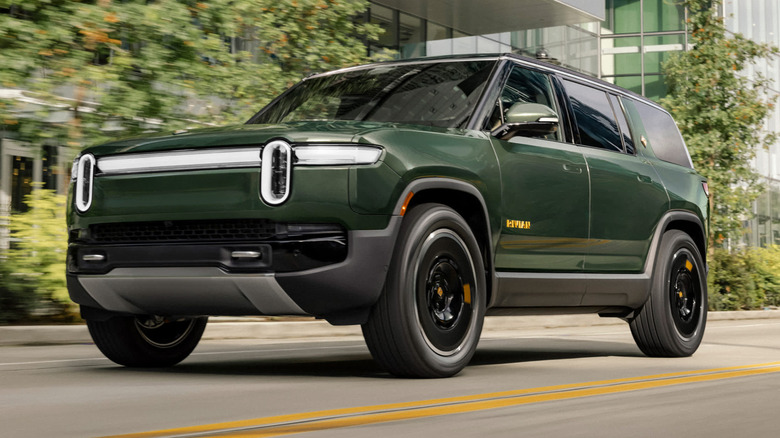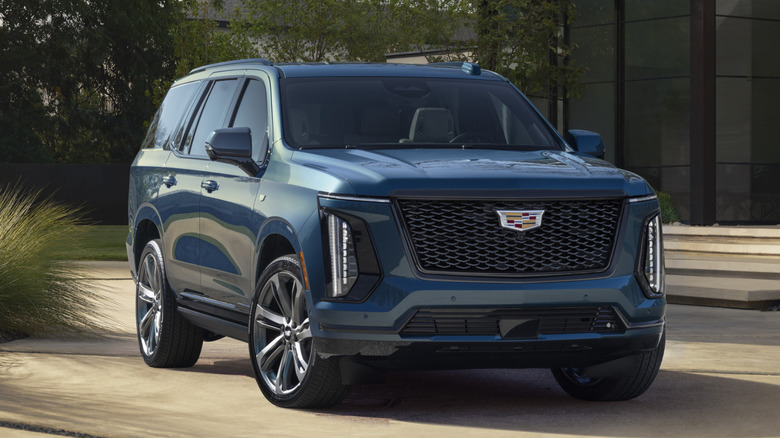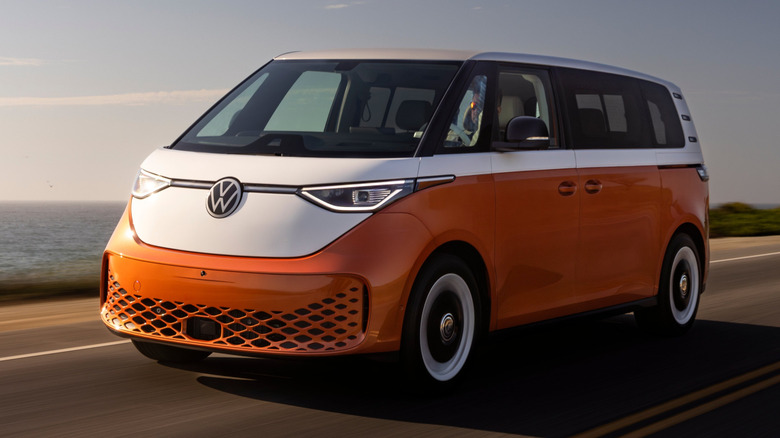10 Boxy Cars You Can Buy In 2025
The industry-wide quest for increased efficiency means that many modern cars are designed to be as aerodynamic as possible. The more aerodynamic a car is, the less drag it will create, and less drag equals less fuel used. With restrictive emissions regulations in place around the globe and a push for automakers to make their EVs as long-range as possible, most designers can no longer afford to ignore aerodynamics when penning their latest creations.
However, there are still a few manufacturers that happily produce cars that have all the aerodynamics of a flying brick. Sometimes, that comes down to a connection to the model's heritage, with retro-modern styling being a particularly popular trend among SUVs in the current market. However, not all modern boxy cars feature retro styling. Some look that way simply because manufacturers want them to stand out. And, in a market full of increasingly similar-looking crossovers and SUVs, they certainly do.
Kia Soul
While many of the boxy cars on the market are pricey, upmarket SUVs, the Kia Soul is one of the most affordable new cars you can buy. For 2025, it starts from $20,490 excluding destination fee. It remains one of the most distinctive-looking cars in Kia's lineup, with similarities to the now-discontinued Nissan Cube. While the Cube never sold well enough to keep its place in Nissan's American dealerships, the Soul has proved a success for its maker, with Kia selling more than 50,000 examples of the car in the U.S. in 2024.
Aside from the launch of the Soulmate Special Edition, which features some unique trim and a Harman Kardon audio system, the Soul hasn't changed much for the 2025 model year. As standard, it features a 2.0L four-cylinder engine that produces a modest 147 horsepower. In its most efficient form, it achieves up to 31 mpg combined. Despite its low price, the Soul isn't short of standard tech, although 10-way power driver seats and a lane change assist feature are only available as optional extras.
Ford Bronco
There are plenty of things to consider if you're buying a new Ford Bronco. The SUV starts from around $40,000 and is available with a range of powertrains and in various trims, some of which lean more heavily into the model's off-roading heritage than others. That said, none of the Bronco's current trims are particularly road-oriented, and if you don't plan on leaving the asphalt, the Bronco's appeal might eventually wear thin. Other SUVs of its size handle better on the road, or can carry more cargo or passengers for the same price.
For looks, however, it's difficult to match the Bronco's retro-modern charm. It's one of several modern SUVs that borrow design elements from its predecessors — other notable examples include the Land Rover Defender and the latest Toyota Land Cruiser. Arguably, it strikes the right balance of paying homage without turning into a pastiche of the classic. In other words, it looks good and should age a lot more gracefully than Ford's other notable attempt at retro-modern styling, the revived-then-discontinued Ford Thunderbird of the mid-'00s.
Hyundai Santa Fe
Boxy SUV styling is often associated with all-terrain capability and is sometimes used as a visual indicator to emphasize that the SUV in question hasn't toned down its off-road chops in favor of road-going performance. The Hyundai Santa Fe turns that idea on its head, co-opting the looks usually reserved for heritage off-roaders but without any of the heritage or off-road capability. It's a bold move, but it works well, particularly since the car's H-shaped headlights and taillights give it some unique personality.
Inside, the Santa Fe borrows styling cues from modern luxury SUVs, with ambient lighting throughout the cabin for an upmarket touch. It helps make the Santa Fe feel like an appealing, cheaper alternative to more premium SUVs, although its top-spec trims reach prices that get close to those premium rivals. A fully-loaded Santa Fe Calligraphy with every option ticked can reach almost $55,000. Granted, you get a plush leather interior and a long list of equipment for that price, but it's still far from a bargain. In fact, several other boxy SUVs with actual off-road capability can be had for the same price or less.
GMC Yukon
All full-size SUVs look imposing to some degree, but the 2025 GMC Yukon casts a particularly menacing shadow in the rear-view mirror of any small car. Not only is it physically large, but its huge grille and boxy proportions add to the overall sense of size. When it's off-road, the Yukon's adaptive air suspension can also lift it up by a further two inches, to increase ground clearance over rough terrain. Buyers have the choice of picking between gas and diesel power for 2025, with the latter arriving courtesy of a new 3.0L DuraMax Turbodiesel engine.
The Yukon is at its most lavish in Denali Ultimate trim, which features a 22-speaker Bose audio system and 16-way power heated and ventilated front seats, among other unique features. It also comes with a suite of safety and assistance features as standard, to help drivers better manage its overall heft. The Yukon Denali starts from $77,500 for 2025, although a Yukon Denali Ultimate will stretch into six-figure territory.
Jeep Wrangler
Jeep made a few changes to the Wrangler for 2025, including bringing back the combination of the 3.6L V6 engine and automatic transmission. The powertrain might be new, but the Jeep's boxy styling — and of course its off-road chops — remain unchanged. The SUV's appeal still centers around its ability to conquer all types of terrain, but Jeep has made improvements to its on-road handling and added extra tech in recent years. New additions for 2025 include an option to ventilate the cabin remotely via Jeep's app, and standard power windows even for base models.
Aside from the aforementioned 3.6L V6, buyers have plenty of other engine options to choose from. The base-spec option is a 2.0L turbocharged four-cylinder engine with 270 horsepower on offer, but it can also be paired with two electric motors in the plug-in hybrid Wrangler 4xe. A 6.4L V8 engine is still available at the top of the Wrangler range, with 470 horsepower on tap.
Mercedes G-Class
Even though the Mercedes G-Wagen can now be bought in all-electric form, it has not lost its classic styling. In fact, Mercedes has done a remarkably good job of preserving the original proportions, given the layout changes necessitated by the introduction of a battery and motors. It's also not lost any of its off-road capability, as our reviewer found out when putting the G through its paces in the hills of Los Angeles County.
Unfortunately, for buyers who don't have six figures to spend on their boxy off-roader, the G-Class has also retained its high starting price. The cheapest gas-powered variant starts around $150,000 for 2025, while the all-electric version starts from roughly $162,000. Buyers looking for the top-spec AMG G63 will have to shell out at least $186,100.
Those kinds of prices ironically put the G-Class out of reach of most buyers who might be willing to make the most of its all-terrain capabilities. Despite being more at home on rutted trails than it is on the highway, it's safe to assume that most buyers of the new G-Class won't be subjecting it to any terrain that a boxy pretender like the Hyundai Santa Fe couldn't handle.
Rivian R1S
In response to an ever-increasing field of rivals, Rivian has given both the R1S and R1T a makeover for 2025. The pair are now more powerful, more refined to drive, and better equipped than before, but pricing hasn't changed significantly. Neither has the looks of either the truck or the R1S SUV, which still feature the distinctive headlights and block-like appearance of earlier models. Some minor changes have been made, however, with the rear taillights being tweaked and the cabin featuring more premium materials than before.
The headline new addition is the revamped Quad-Motor variant, which offers 1,025 horsepower and serves as the brand's flagship model. The Tri-Motor is the next step down in the range, but it will still cost six figures. The base Dual-Motor R1S is slightly less costly, and can be bought for under $80,000. Rivian might still be a small name in the automotive industry, but thanks to a $5.8 billion investment from Volkswagen that was announced in November 2024, buyers should expect to see more of the company in the near future. The brand's second model, the R2, is due for launch in 2026, and retains the same boxy styling as its larger sibling.
Cadillac Escalade
Another SUV that's been given a makeover for 2025 is the Cadillac Escalade, which features revised styling and a new suite of tech features. However, its new looks haven't changed its overall shape, which remains as boxy as before. Chief among the visual changes is a revised headlight design, which borrows from the brand's all-electric vehicles. New, 24-inch wheels are also available, which Cadillac says is the largest ever offered on an Escalade. They're also some of the largest ever seen on a production SUV — for context, just a decade ago, even the Jaguar F-Pace's 22-inchers were considered unprecedented.
The Escalade has always been about excess, though, and the 2025 model certainly doesn't change that. Buyers looking for the most opulent additions to their Caddy SUV can add the Executive Second Row package, which features extras including integrated headrest speakers, personal 12.6-inch infotainment screens, and aircraft-style fold-away tray tables. The brand also notes that its ambient lighting system now stretches to 126 different colors, while its 55-inch, dash-spanning infotainment display is even more over-the-top than the 2024 model's 38-inch display. Of course, all this comes at a significant cost, with the Escalade starting from $89,590 for 2025.
Nissan Armada
The revised Nissan Armada is more luxurious than before, but it's no less large and no less slab-sided. If anything, the latest Armada, which debuts for 2025, looks slightly more monolithic than before thanks to its chunky new grille and revised headlights. Inside, the cabin is now closer in style and materials to premium manufacturers, at least in the configuration of our Armada Platinum tester. As well as the leather upholstery, the Platinum also features a smattering of additional high-end tech, plus a two-speed gearbox for rougher terrain.
Also present throughout the cabin is a carefully placed array of ambient lighting. It isn't quite as customizable as the system in the Cadillac Escalade — while the Caddy offers 126 colors, Armada buyers will have to face the sheer horror of having a mere 64 colors at their disposal — but it does come cheaper. Far cheaper, in fact. Despite the Armada's push upmarket, Nissan has wisely stayed away from the price brackets occupied by luxury brands, with the 2025 Armada starting from just under $60,000. The range-topping Platinum Reserve will cost at least $76,990, excluding fees.
VW ID.Buzz
A retro-modern resurrection of the classic Type 2, the VW ID.Buzz is arguably a closer successor to the original than the gas-powered T7 Multivan that's technically its more direct descendent. VW doesn't offer the T7 Multivan in America anyway, and it's not like buyers are missing out — the ID.Buzz offers a similarly practical interior, the advantage of instant electric torque, and of course its distinctive, T1-derived looks. The only significant downside is its range, which at around 230 miles, lags behind most modern EVs.
Still, we walked away from a week with the ID.Buzz having been won over by its charms, with its unique looks drawing plenty of attention from passersby during that time. It's certainly unusual, and for now, it's a rare sight on the roads, but this heritage-tinged EV is also fairly pricey. The base-spec variant starts from around $60,000, while a First Edition with all-wheel drive will cost at least $70,000. At that price, there are plenty of other EVs available that offer greater luxury or longer range, but none offer quite the same boxy looks as VW's latest van.
